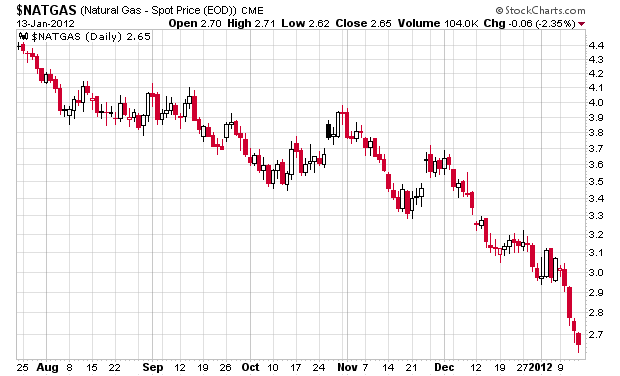Tag: ECA
Thumb twiddling
The biggest mistake any investor can do is just invest cash for the purpose of investing it in something instead of investing it in something proper.
Hence, I am still twiddling my thumbs.
Curiously I do notice Encana (TSX: ECA) is up about 6% despite the fact that natural gas futures are still depressed. Might be a sign of short covering?
I’ve also been doing some research on R.R. Donnelley & Sons Company (NYSE: RRD) – I have owned their corporate debt in the past so I have not had to do much additional work. They are facing the same issues that Yellow Media had, mainly a good chunk of their business (catalogs and cheque printing) is getting enveloped by the online world. Still, the company is hugely cash flow positive and doesn’t even have the debt albatross that Yellow Media has. If it wasn’t for the fact that they are a well-known case, I might dip my toes in.
There are a couple other smallish-cap companies ($100M-$250M range) that I am reluctant to mention here that seem to have very compelling valuations, plus almost no financial pundits are paying any attention to them.
The great thing about having a large cash position is that it feels like I am working with a blank canvass. Despite earning almost nothing in yield for cash, I also do not feel pressured to make any portfolio decisions. If I have to wait out an entire year without hitting any candidates, so be it.
Natural gas continues its trek down
A fairly mundane day in the market, but there is one item that has been flashing red on my screen for the past week, and that is the spot price for natural gas:
The March contract is trading at $2.50/mmBtu and this is very close to the lows that were reached during the 2008-2009 financial crisis. At present prices, it becomes very uneconomical to develop produce natural gas and it makes you wonder how long it will be before you start seeing insolvencies in natural gas companies. Those that have over-leveraged themselves will be facing the consequences soon.
I look at companies like Encana (TSX: ECA) – their operating and transport costs is approximately $1.60-$1.70/Mcf, which is still well below spot price. It explains the $12 billion market capitalization, but it makes you wonder when the bottom will be for it and also the spot price.
The geopolitical premium
Oil has been rising steadily over the past month:
This is, in large part, due to the geopolitical premium that has built up in the commodity on fears of supply disruption from a potential strike on Iran from Israel. Other commodities have been roughly flat, with the notable exception of Natural Gas crashing through the floor:
Until we start seeing more consolidation and shutdowns of natural gas drillers and producers, this supply-demand picture is not going to be changing anytime soon. Big fish such as Encana (TSX: ECA) look cheap, but until we start seeing liquidations of smaller players or spontaneous construction of significant amounts of natural gas burning facilities, I would not be touching natural gas commodities. Notably in the peak of the last economic crisis, natural gas went down to US$2.5/mmBtu and at that level it would bankrupt most leveraged small producers. Larger companies like Encana just need to wait with a pile of cash and mop up when the time is right.
As for the oil markets, it will remain volatile as traders are seemingly using it as a proxy for geopolitical event risk.
Encana – PetroChina deal fallout not that bad
I notice natural gas titan Encana (TSX: ECA) traded a bit lower after they announced that their previously announced joint venture with PetroChina for a shale gas field fell through.
I do not view this as being too adverse an event – Encana’s management has typically been quite long-range viewing and they are dealing with a very difficult situation in the natural gas market, with spot prices currently CAD$4.30ish and typical marginal costs of extraction higher than this. They have frequently stated that they believe the natural gas marketplace is artificially low and the best thing for resource companies with plenty of reserves on the ground is to wait for higher commodity prices before drilling. My guess is that PetroChina’s management had more of a short term focus.
Back in fiscal 2008, spot natural gas went well above $10 and Encana had a banner year on earnings, reporting over $8/share (note the 2008 number is not a direct comparison with the present company because the company split off Cenovus in 2009 which also benefited from $150 crude oil). If we ever see higher natural gas prices, Encana should be well positioned to capitalize. Currently with shale gas drilling there is a huge supply glut in the marketplace.
In 2010 the company earned $2/share on an average spot natural gas price of about $4.25 per mmBtu. Encana at present values appears to be a fairly good “grandmother” type stock that should retain its value even in adverse market conditions. Even in the depths of the 2009 economic crisis (which is generally what I use to gauge maximum downside) the stock did not trade lower than 20% below existing market values.
It is an interesting comparison to look at a company like Microsoft and ask oneself whether it is likely in the medium range future whether licenses for Windows and Office will be more or less valuable a commodity than natural gas.


